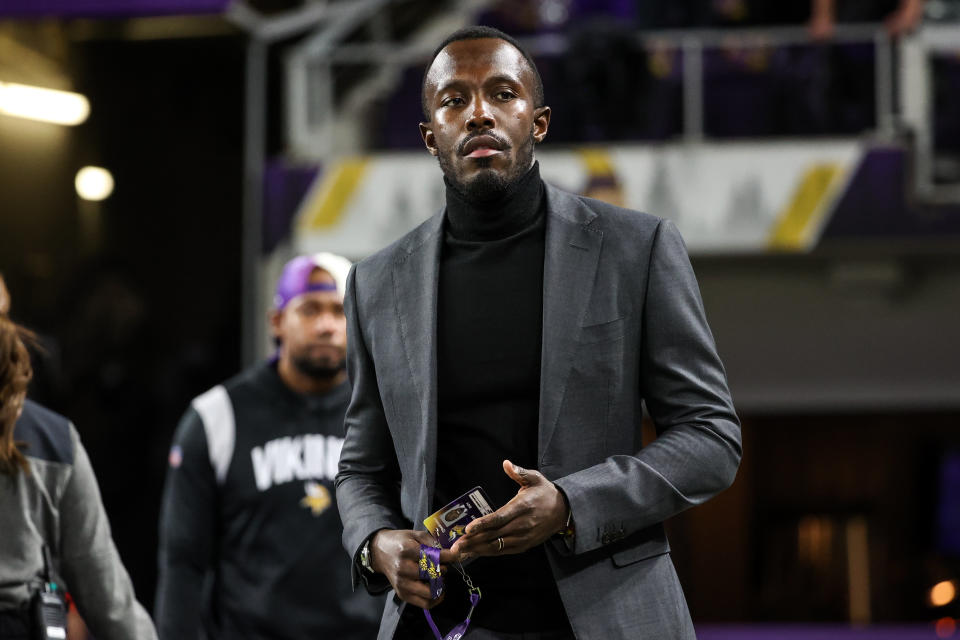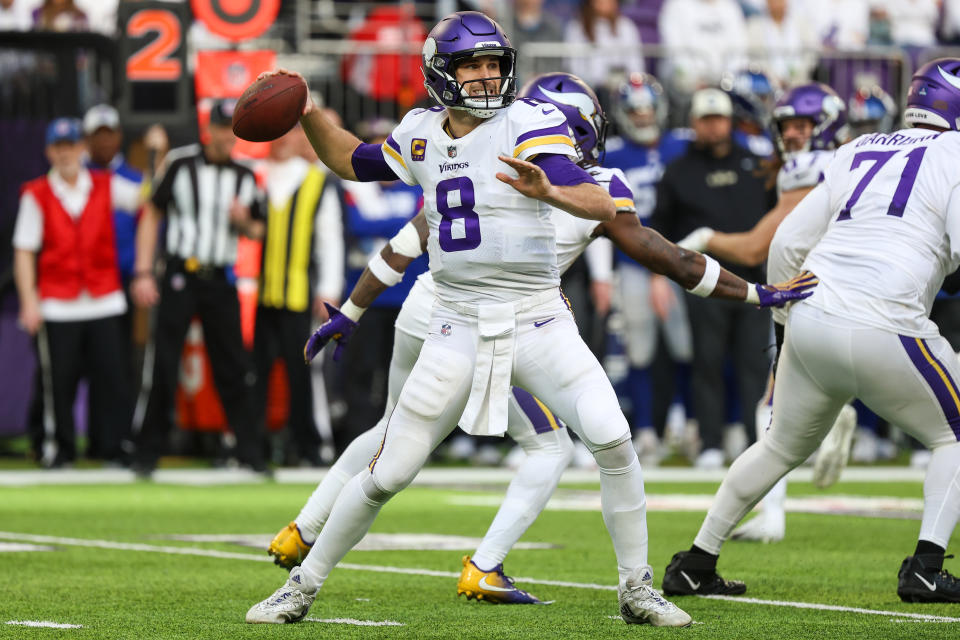Explaining the rookie quarterback development clock

If you’ve consumed any NFL media during the off-season, you’ve likely heard of the “QB developmental clock.”
The concept might sound foreign, but it’s simple to understand. As the theory goes, having a quarterback on his rookie-scale contract is valuable. It allows teams to build the team in different ways and opens up a better pathway to success.
For some, this concept is a crutch. There’s a belief among some that you can only win if you have either a young quarterback on a cheap contract or a superhuman signal-caller with an alien-like ability (see: Patrick Mahomes).
As the Minnesota Vikings enter the offseason, his concept will become a talking point. Kirk Cousins is at the tail end of his career, and he’s a free agent in 2024. In a way, general manager Kwesi Adofo-Mensah and Kevin O’Connell can begin a new clock by drafting a rookie quarterback and riding with the youth.
The question now becomes: how viable of a strategy is this, and how does it help in team building?
Regarding viability, another question is if Minnesota should pursue such an idea or offer Cousins an extension.
Historical Precedent

Mark Konezny-USA TODAY Sports
Twelve quarterbacks were selected between picks 5 and 32 in the NFL Draft between 2017 and 2021. This list removes quarterbacks picked in the top three because the Vikings likely don’t have the assets to move into this part of the draft.
Kenny Pickett, the 20th selection in the 2022 Draft, is also removed because he hasn’t had a chance to impact the Steelers’ teambuilding approach.
Those twelve quarterbacks are as follows:
Note: Quarterbacks are sorted by games started
Patrick Mahomes (2017 NFL Draft/Pick 10/Kansas City Chiefs): 80 games started
Josh Allen (2018/Pick 7/Buffalo Bills): 76 games
Lamar Jackson (2018/Pick 32/Baltimore Ravens): 61 games
Deshaun Watson (2017/Pick 12/Houston Texans): 59 games
Daniel Jones (2019/Pick 6/New York Giants): 53 games
Justin Herbert (2020/Pick 6/Los Angeles Chargers): 49 games
Tua Tagovailoa (2020/Pick 5/Miami Dolphins): 34 games
Mac Jones (2021/Pick 15/New England Patriots): 31 games
Justin Fields (2021/Pick 11/Chicago Bears): 25 games
Josh Rosen (2018/Pick 10/Arizona Cardinals): 16 games
Dwayne Haskins (2019/Pick 15/Washington Commanders): 13 games
Jordan Love (2020/Pick 26/Green Bay Packers): 1 game
Let’s get the obvious out of the way: this list is a mixed bag of success.
Patrick Mahomes is a two-time Super Bowl Champion and five-time Pro Bowler. Josh Allen has yet to win a Super Bowl, but he is a two-time Pro Bowler who is one of the best quarterbacks in football.
On the other side of the spectrum, Josh Rosen is currently a free agent. After starting 13 games in his rookie season, Rosen has started just three games since and went 0-3 in those games. Rosen was traded after his rookie season to the Miami Dolphins for a second-round and fifth-round pick.
The Miami Dolphins' Approach

ALLEN EYESTONE / THE PALM BEACH POST
Speaking of the Dolphins, let’s start with their approach to maximizing their affordable quarterback.
Dolphins quarterback Tua Tagovailoa accounts for $9 million against the cap in 2023, making him the 18th-highest-paid quarterback.
The Dolphins have attempted to maximize this contract through highly-paid veterans at other valuable positions. Last off-season, the Dolphins signed left tackle Terron Armstead to a 5-year, $75 million contract; and followed that up by making Tyreek Hill the highest-paid wide receiver in the sport.
At the trade deadline, the Dolphins traded a first-round selection for edge rusher Bradley Chubb. Chubb was given a contract extension worth $110 million over five seasons.
Outside of those contracts, Tagovailoa’s cap hit has also allowed them to sign players like offensive lineman Connor Williams and defensive end Emmanuel Ogbah.
Ogbah and Williams aren’t the highest-paid players on the Dolphins, but it’s hard to imagine a situation where they could pay Tagovailoa and keep both, or either, of them.
Overall, judging if the Dolphins’ approach is successful seems fruitless because it’s been less than a year since these contracts were signed. The Dolphins did make the playoffs this season but were quickly eliminated in the AFC Wild Card Round. However, Tagovailoa’s cap hit has allowed the Dolphins to maximize their output at “valuable” positions, like offensive tackle and edge rusher.
The Baltimore Ravens' Approach

Tommy Gilligan-USA TODAY Sports
The Baltimore Ravens took a different approach, pooling much of their cap space into the defensive side of the ball.
In 2020, edge rusher Matthew Judon was the Ravens’ highest-paid player, accounting for 8.49% of the cap. Cornerback Marcus Peters accounted for 7.58% of the team’s cap, while defensive tackle Brandon Williams was the team’s third highest-paid player. Overall, their five highest-paid players were all on the defensive side of the ball.
At this time, Lamar Jackson accounted for only 1.31% of the Ravens’ space. This was large because he was selected with the last pick in the first round, meaning his rookie scale contract was significantly lower.
Fast forward to 2022, and Jackson was the Ravens’ highest-paid player at $23.01 million. This cap hit accounted for 11.23% of the team’s overall space. Marcus Peters was second on the team, accounting for 7.56% of the Ravens’ space.
The Ravens paying Lamar Jackson has certainly limited their cap space, but not as much as some expect. The Ravens paid Peters and Marlon Humphrey a combined $26 million while giving an offensive lineman (Ronnie Stanley) a significant contract.
The Kansas City Chiefs' approach

AP Photo/Charlie Riedel
I’d be remiss if I didn’t discuss the elephant (and success) in the room with Kansas City Chiefs quarterback Patrick Mahomes.
Fresh off a Super Bowl win in 2020, the Chiefs were playing Mahomes $5.3 million for the 2020 season. His 2020 cap hit accounted for just over 2% of the team’s total space, allowing them to pay for high-impact players.
Frank Clark and Tyreek Hill were their two highest-paid players, accounting for a combined 16% of the team’s space. That season, the Chiefs paid large amounts of money to safety Tyrann Mathieu and wide receiver Sammy Watkins.
It seems almost crazy that the Chiefs were paying Hill and Watkins a combined $33 million because, in 2022, the Chiefs had one of the cheapest wide receiver rooms in the league.
Mahomes’ big contract and the team’s shift to focusing on their offensive line meant the Chiefs had to trade Hill away because his new extension would not fit inside the team’s cap space.
The impact hasn’t been dire on the Chiefs, but as previously mentioned, Mahomes is a freak of nature quarterback. Comparing success with Mahomes seems unfair to the general NFL.
What about the Vikings?

Matt Krohn-USA TODAY Sports
You’ve likely heard the saying, “the cap space is fake,” but such an idea is wrong. While the cap space is easily manipulatable, it doesn’t mean there aren’t consequences to doing so.
Even if you kick the can down the road, per se, NFL teams will eventually face the consequences for doing so.
Last season, the Los Angeles Rams and New Orleans Saints struggled to acquire quality depth because of the cap gymnastics they did in previous situations. That led to both teams missing the playoffs, despite the Rams winning the Super Bowl the season prior.
Now, what about the Minnesota Vikings?
Vikings General Manager Kwesi Adofo-Mensah has some work to do with the team’s cap space. The Vikings are currently $24 million over the cap, meaning they’ll have to make some moves to become cap compliant.
There are moves the Vikings can make to become cap compliant, including some potential restructurings, but every option comes with a cost.
Getting cheaper at the quarterback position would allow the Vikings to upgrade at various places and pay a premium for players worth a hefty price tag.
It would also allow the Vikings to pay Justin Jefferson and make other moves. Not extending Jefferson would be flat-out awful, but his extension will come at a price. Paying Jefferson the equivalent of a middle-tier quarterback while having Cousins on the books presents a unique challenge for the Vikings.
By getting cheaper at the quarterback position, the Vikings can treat Jefferson’s contract like their big-money quarterback move and still have a young quarterback they can mold.
The case for extending quarterbacks

Matt Krohn-USA TODAY Sports
Quarterback is the most valuable position on the field. Everyone knows this, so let’s not act like it isn’t.
If the Vikings were in a rebuild, acquiring a younger quarterback and letting him go through his valleys as the starter would be a sound strategy. However, the Vikings shouldn’t hit the reset button after winning the NFC North last season.
Kirk Cousins is not a perfect quarterback, but he’s more than serviceable and can lead a team to the playoffs. That has value in itself, especially when another option is mediocrity.
There is no guarantee that drafting a quarterback leads to success, either. As the list of quarterbacks provided earlier proves, some quarterbacks don’t develop into franchise options.
Put it this way: would you rather have Josh Rosen or Kirk Cousins?
The 2023 NFL Draft has its fair share of potential franchise quarterbacks, but there is no guarantee that any of them develop into that.
Take Anthony Richardson and Will Levis, for example. Both have the physical tools to be elite quarterbacks but are also raw in different ways. Richardson is likely further along than Levis, but it doesn’t mean he’s a surefire Pro Bowler or long-term starter in the NFL. Reality isn’t like Madden, and development isn’t a guarantee.
By extending Cousins, the Vikings guarantee themselves some form of consistent quarterback play. The Vikings know what they’re getting out of Cousins and can prepare for that.
It doesn’t mean the Vikings should not look for their future quarterback, but drafting one this season does come with inherent risk.

